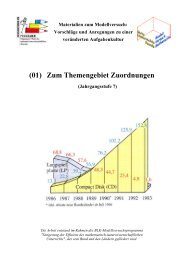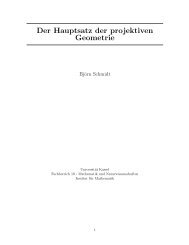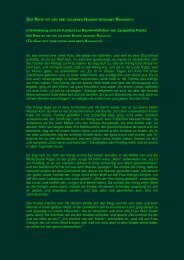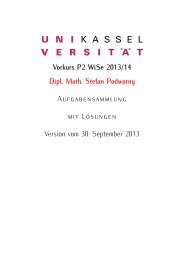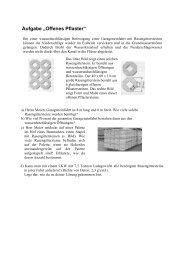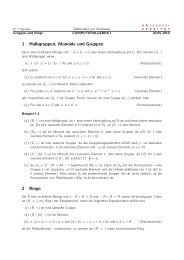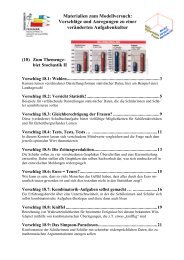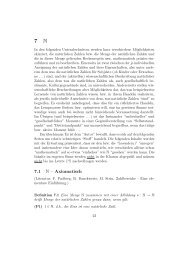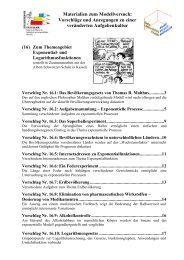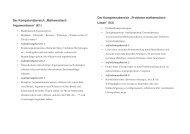Recurrence equations and their classical orthogonal polynomial ...
Recurrence equations and their classical orthogonal polynomial ...
Recurrence equations and their classical orthogonal polynomial ...
Create successful ePaper yourself
Turn your PDF publications into a flip-book with our unique Google optimized e-Paper software.
314 W. Koepf, D. Schmersau / Appl. Math. Comput. 128 (2002) 303–327<br />
with two possible solutions e ¼ 2a that give the differential <strong>equations</strong><br />
<strong>and</strong><br />
ðx 2<br />
ðx 2<br />
4Þy 00 ðxÞþ2ðx þ 1Þy 0 ðxÞ nðn 3ÞyðxÞ ¼0; ð27Þ<br />
4Þy 00 ðxÞþ2ðx 1Þy 0 ðxÞ nðn 3ÞyðxÞ ¼0: ð28Þ<br />
They correspond to the densities<br />
rffiffiffiffiffiffiffiffiffiffiffi<br />
4 þ x<br />
qðxÞ ¼<br />
4 x<br />
<strong>and</strong><br />
rffiffiffiffiffiffiffiffiffiffiffi<br />
4 x<br />
qðxÞ ¼ ;<br />
4 þ x<br />
respectively, hence the <strong>orthogonal</strong> <strong>polynomial</strong>s are multiples of the Jacobi<br />
ð1=2; 1=2Þ<br />
ð 1=2;1=2Þ<br />
<strong>polynomial</strong>s Pn ðx=2Þ <strong>and</strong> Pn ðx=2Þ.<br />
Finally, in the third of the above cases, i.e., for d ¼ 3a, we get again e ¼ 0<br />
<strong>and</strong><br />
ðx 2<br />
4Þy 00 ðxÞþ3xy 0 ðxÞ nðn 4ÞyðxÞ ¼0 ð29Þ<br />
corresponding to the density<br />
qðxÞ ¼<br />
1<br />
rðxÞ exp<br />
Z<br />
sðxÞ<br />
rðxÞ<br />
ffiffiffiffiffiffiffiffiffiffiffiffi<br />
dx ¼ 4 x2 p<br />
:<br />
The corresponding <strong>orthogonal</strong> <strong>polynomial</strong>s are multiples of translated<br />
Chebyshev <strong>polynomial</strong>s of the second kind<br />
pnðxÞ ¼knSnðxÞ ¼ p0<br />
n þ 1 SnðxÞ ¼ p0<br />
n þ 1 Unðx=2Þ ðn P 0Þ ð30Þ<br />
(see e.g. [1], Table 22.2, <strong>and</strong> (22.5.13); SnðxÞ are monic, see also Table 22.8),<br />
hence<br />
PnðxÞ ¼pn 1ðxÞ ¼ P1<br />
n Un 1ðx=2Þ ðn P 1Þ:<br />
We see that the recurrence equation (24) has four different (shifted) linearly<br />
transformed <strong>classical</strong> <strong>orthogonal</strong> <strong>polynomial</strong> solutions!<br />
Using our implementation, these results are obtained by<br />
> strict: ¼ true:<br />
> RE :¼ ðn þ 3Þ pðn þ 2Þ x ðn þ 2Þ pðn þ 1Þþðn þ 1Þ pðnÞ ¼0;<br />
RE :¼ ðn þ 3Þpðn þ 2Þ xðn þ 2Þpðn þ 1Þþðn þ 1ÞpðnÞ ¼0<br />
> REtoDE(RE,p(n),x);





